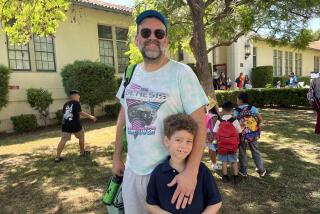The Quake’s Littlest Victims : Youth: School program provided art therapy, counseling and safety training to undo January’s trauma.
- Share via
TARZANA — After the Northridge earthquake, 8-year-old Leilani Sanders began to have problems at school. The quality of her work declined, and her behavior became terrible, her mother said.
Like many other students at Tarzana Elementary, the quake forced Leilani from her home. But those around her quickly discovered that the disaster’s psychological toll rivaled the physical damage.
For many children, when their homes collapsed, so did their sense of security.
On Thursday, more than 100 of these littlest victims of the quake--for whom words can be difficult and comprehension of a disaster harder still--celebrated their personal recoveries, which were assisted by trauma therapy groups at school.
The earthquake “made me feel scared,” Leilani said. “It keeps on shaking and you can’t get away from it. They said, ‘Don’t be scared, because the shocks will stop.’ I feel happy, kind of, because they told me it was OK.”
In a ceremony complete with cake, applause and certificates for each child, the school community came together to honor their youngsters’ progress.
Starting in January, using a grant from the Federal Emergency Management Agency, support from the Los Angeles Unified School District and individual donations, school officials hosted three teams of counselors.
In addition to LAUSD counselors, a FEMA-sponsored group worked individually with the more troubled students and a group from Cedars-Sinai Medical Center in Los Angeles led the youngsters in art therapy sessions, in which the children drew images of themselves and their homes.
“Children can express their feelings through pictures and then talk about their feelings,” Tarzana Principal Roberta MacAdam explained after Thursday’s ceremony. “If they draw a house falling down, the object is to get them to talk about it, so at the end of the sessions they can draw a picture with the house all put back together.”
Many of the children were suffering from a feeling of powerlessness, especially in the face of a problem even adults around them couldn’t handle, said Suzanne Silverstein of the Psychological Trauma Center at Cedars-Sinai. So the students were also taught how to make themselves safe.
“As adults, part of our responsibility is to teach our children what they need to know to go through life,” Silverstein said. “When there’s a disaster, it’s the responsibility of the adults to help the child understand what’s transpired.”
Children were taught how to make their bedrooms earthquake-secure and assemble an earthquake kit. They are not helpless, they were assured, and were reminded that everybody needs a hand to hold when they are scared.
Silverstein said Leilani’s behavior was typical. Unable to express themselves in speech as adults do, children often act their feelings out.
Debbie Sanders, the girl’s mother, was relieved by her daughter’s newfound ability to cope with the disaster.
“Her teacher has said, ‘I’ve got my old Leilani back,’ ” Sanders said.
More to Read
Sign up for Essential California
The most important California stories and recommendations in your inbox every morning.
You may occasionally receive promotional content from the Los Angeles Times.













